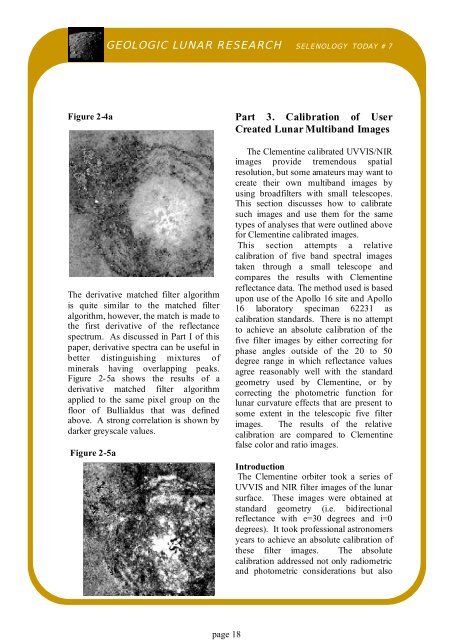Selenology Today # 7 July 2007 - Home
Selenology Today # 7 July 2007 - Home
Selenology Today # 7 July 2007 - Home
Create successful ePaper yourself
Turn your PDF publications into a flip-book with our unique Google optimized e-Paper software.
Figure 2-4a<br />
GEOLOGIC LUNAR RESEARCH SELENOLOGY TODAY # 7<br />
The derivative matched filter algorithm<br />
is quite similar to the matched filter<br />
algorithm, however, the match is made to<br />
the first derivative of the reflectance<br />
spectrum. As discussed in Part I of this<br />
paper, derivative spectra can be useful in<br />
better distinguishing mixtures of<br />
minerals having overlapping peaks.<br />
Figure 2-5a shows the results of a<br />
derivative matched filter algorithm<br />
applied to the same pixel group on the<br />
floor of Bullialdus that was defined<br />
above. A strong correlation is shown by<br />
darker greyscale values.<br />
Figure 2-5a<br />
page 18<br />
Part 3. Calibration of User<br />
Created Lunar Multiband Images<br />
The Clementine calibrated UVVIS/NIR<br />
images provide tremendous spatial<br />
resolution, but some amateurs may want to<br />
create their own multiband images by<br />
using broadfilters with small telescopes.<br />
This section discusses how to calibrate<br />
such images and use them for the same<br />
types of analyses that were outlined above<br />
for Clementine calibrated images.<br />
This section attempts a relative<br />
calibration of five band spectral images<br />
taken through a small telescope and<br />
compares the results with Clementine<br />
reflectance data. The method used is based<br />
upon use of the Apollo 16 site and Apollo<br />
16 laboratory speciman 62231 as<br />
calibration standards. There is no attempt<br />
to achieve an absolute calibration of the<br />
five filter images by either correcting for<br />
phase angles outside of the 20 to 50<br />
degree range in which reflectance values<br />
agree reasonably well with the standard<br />
geometry used by Clementine, or by<br />
correcting the photometric function for<br />
lunar curvature effects that are present to<br />
some extent in the telescopic five filter<br />
images. The results of the relative<br />
calibration are compared to Clementine<br />
false color and ratio images.<br />
Introduction<br />
The Clementine orbiter took a series of<br />
UVVIS and NIR filter images of the lunar<br />
surface. These images were obtained at<br />
standard geometry (i.e. bidirectional<br />
reflectance with e=30 degrees and i=0<br />
degrees). It took professional astronomers<br />
years to achieve an absolute calibration of<br />
these filter images. The absolute<br />
calibration addressed not only radiometric<br />
and photometric considerations but also


